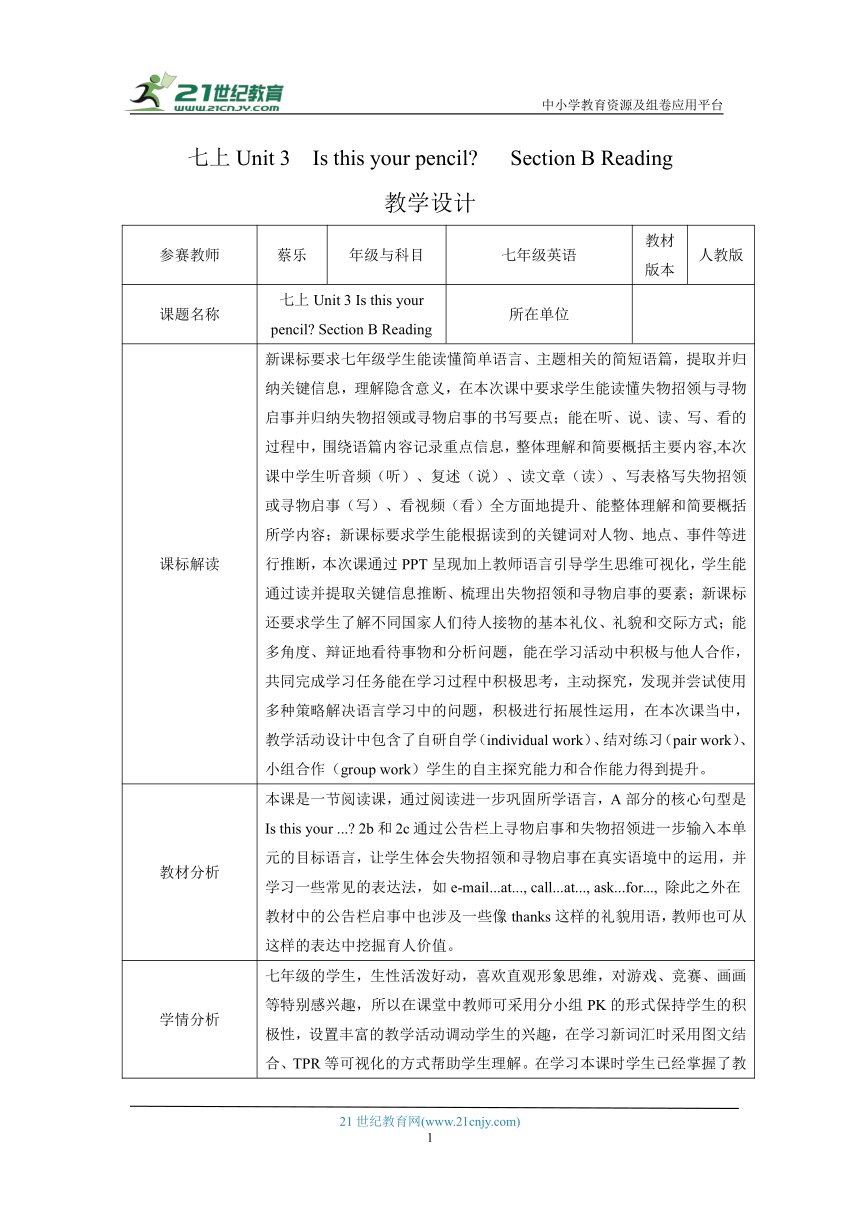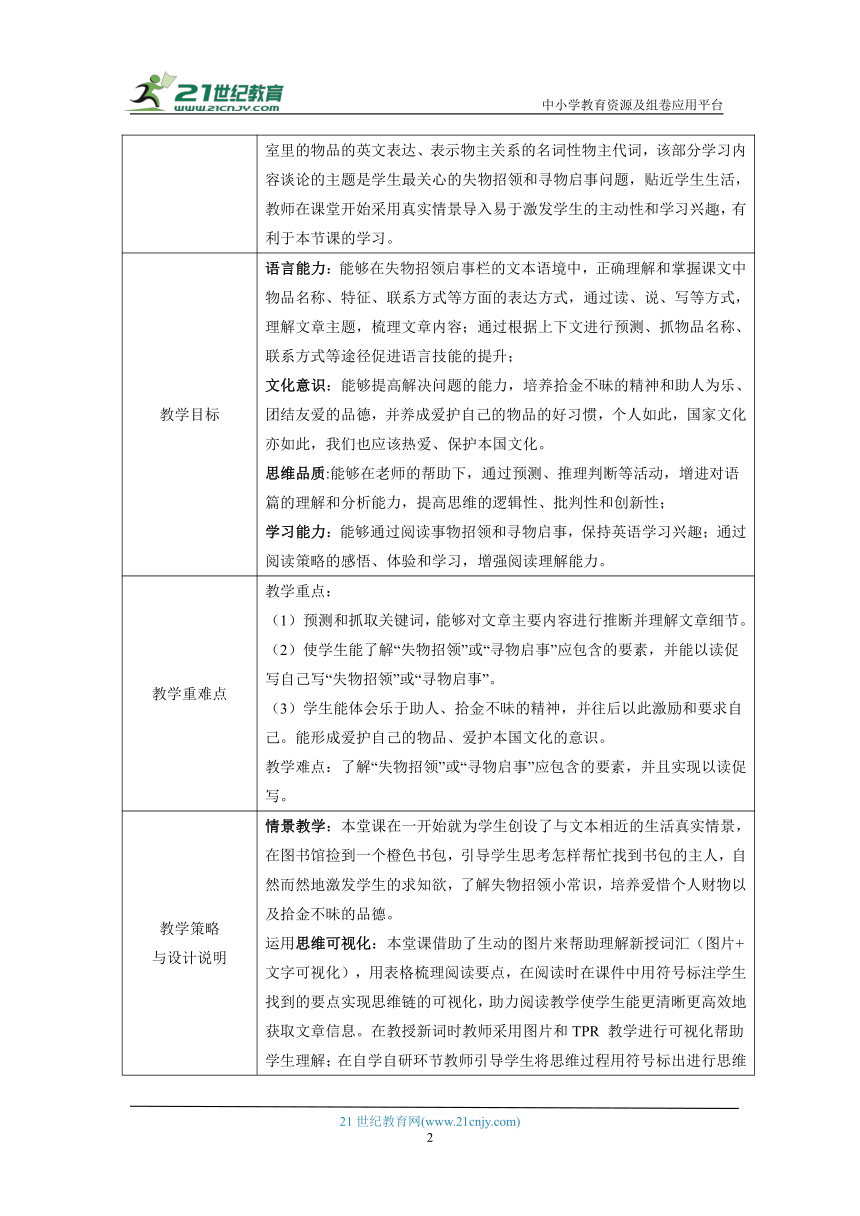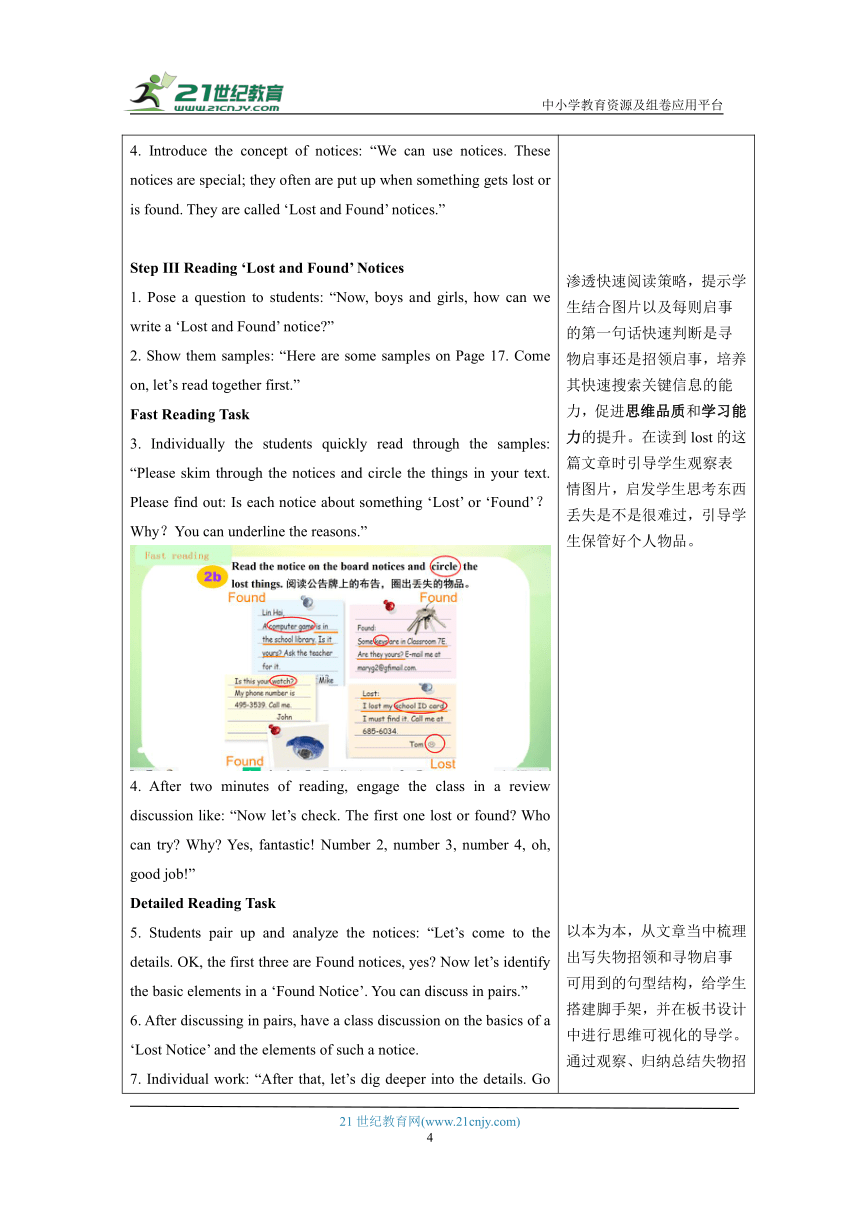(新课标)Unit 3 Is this your pencil Section B 2a-2c Reading 表格式教学设计
文档属性
| 名称 | (新课标)Unit 3 Is this your pencil Section B 2a-2c Reading 表格式教学设计 |  | |
| 格式 | docx | ||
| 文件大小 | 1.0MB | ||
| 资源类型 | 试卷 | ||
| 版本资源 | 人教新目标(Go for it)版 | ||
| 科目 | 英语 | ||
| 更新时间 | 2024-01-03 21:45:16 | ||
图片预览




文档简介
中小学教育资源及组卷应用平台
七上Unit 3 Is this your pencil Section B Reading
教学设计
参赛教师 蔡乐 年级与科目 七年级英语 教材版本 人教版
课题名称 七上Unit 3 Is this your pencil Section B Reading 所在单位
课标解读 新课标要求七年级学生能读懂简单语言、主题相关的简短语篇,提取并归纳关键信息,理解隐含意义,在本次课中要求学生能读懂失物招领与寻物启事并归纳失物招领或寻物启事的书写要点;能在听、说、读、写、看的过程中,围绕语篇内容记录重点信息,整体理解和简要概括主要内容,本次课中学生听音频(听)、复述(说)、读文章(读)、写表格写失物招领或寻物启事(写)、看视频(看)全方面地提升、能整体理解和简要概括所学内容;新课标要求学生能根据读到的关键词对人物、地点、事件等进行推断,本次课通过PPT呈现加上教师语言引导学生思维可视化,学生能通过读并提取关键信息推断、梳理出失物招领和寻物启事的要素;新课标还要求学生了解不同国家人们待人接物的基本礼仪、礼貌和交际方式;能多角度、辩证地看待事物和分析问题,能在学习活动中积极与他人合作,共同完成学习任务能在学习过程中积极思考,主动探究,发现并尝试使用多种策略解决语言学习中的问题,积极进行拓展性运用,在本次课当中,教学活动设计中包含了自研自学(individual work)、结对练习(pair work)、小组合作(group work)学生的自主探究能力和合作能力得到提升。
教材分析 本课是一节阅读课,通过阅读进一步巩固所学语言,A部分的核心句型是Is this your ... 2b和2c通过公告栏上寻物启事和失物招领进一步输入本单元的目标语言,让学生体会失物招领和寻物启事在真实语境中的运用,并学习一些常见的表达法,如e-mail...at..., call...at..., ask...for..., 除此之外在教材中的公告栏启事中也涉及一些像thanks这样的礼貌用语,教师也可从这样的表达中挖掘育人价值。
学情分析 七年级的学生,生性活泼好动,喜欢直观形象思维,对游戏、竞赛、画画等特别感兴趣,所以在课堂中教师可采用分小组PK的形式保持学生的积极性,设置丰富的教学活动调动学生的兴趣,在学习新词汇时采用图文结合、TPR等可视化的方式帮助学生理解。在学习本课时学生已经掌握了教室里的物品的英文表达、表示物主关系的名词性物主代词,该部分学习内容谈论的主题是学生最关心的失物招领和寻物启事问题,贴近学生生活,教师在课堂开始采用真实情景导入易于激发学生的主动性和学习兴趣,有利于本节课的学习。
教学目标 语言能力:能够在失物招领启事栏的文本语境中,正确理解和掌握课文中物品名称、特征、联系方式等方面的表达方式,通过读、说、写等方式,理解文章主题,梳理文章内容;通过根据上下文进行预测、抓物品名称、联系方式等途径促进语言技能的提升; 文化意识:能够提高解决问题的能力,培养拾金不昧的精神和助人为乐、团结友爱的品德,并养成爱护自己的物品的好习惯,个人如此,国家文化亦如此,我们也应该热爱、保护本国文化。 思维品质:能够在老师的帮助下,通过预测、推理判断等活动,增进对语篇的理解和分析能力,提高思维的逻辑性、批判性和创新性; 学习能力:能够通过阅读事物招领和寻物启事,保持英语学习兴趣;通过阅读策略的感悟、体验和学习,增强阅读理解能力。
教学重难点 教学重点: 预测和抓取关键词,能够对文章主要内容进行推断并理解文章细节。 使学生能了解“失物招领”或“寻物启事”应包含的要素,并能以读促写自己写“失物招领”或“寻物启事”。 学生能体会乐于助人、拾金不昧的精神,并往后以此激励和要求自己。能形成爱护自己的物品、爱护本国文化的意识。 教学难点:了解“失物招领”或“寻物启事”应包含的要素,并且实现以读促写。
教学策略 与设计说明 情景教学:本堂课在一开始就为学生创设了与文本相近的生活真实情景,在图书馆捡到一个橙色书包,引导学生思考怎样帮忙找到书包的主人,自然而然地激发学生的求知欲,了解失物招领小常识,培养爱惜个人财物以及拾金不昧的品德。 运用思维可视化:本堂课借助了生动的图片来帮助理解新授词汇(图片+文字可视化),用表格梳理阅读要点,在阅读时在课件中用符号标注学生找到的要点实现思维链的可视化,助力阅读教学使学生能更清晰更高效地获取文章信息。在教授新词时教师采用图片和TPR 教学进行可视化帮助学生理解;在自学自研环节教师引导学生将思维过程用符号标出进行思维的可视化;在评价环节教师将评价细化用表格进行可视化。 英语学习活动观:以主题为引领,以语篇为依托,通过学习理解类活动、应用实践类活动、迁移创新类活动,引导学生用英语表达对所学主题的新的认知、态度和价值判断。 教学评一体化教学设计:坚持以评促学、以评促教,将评价贯穿于英语课程教与学的全过程。多种评价方式相结合,比如本课教师包含有非正式评价(口头评价、小组竞赛加分评价)、正式评价(评价表),而且除了师评,还有学生自评、互评。
教学过程
教学内容与师生活动 设计意图
Step Ⅰ Introduction 1. Begin the lesson by greeting the students: “Hello, everyone. I’m your English teacher. My name is Ricky.” 2. Divide the class into groups for later tasks: “Before we begin our class, I’ll divide you into some groups. Groups 1-3, you are Group A. Groups 4-6, you are Group B.” 3. Detail my contact information for any outside-of-class queries: “I’m an English teacher. If you have any questions about English, you can call me at 17680370312. You can also email me at 1659006854@.” And teach the new words “call” and “email” in the situation. Step Ⅱ Creating Context 1. Set up a situation for students: “Yesterday, I went to a very interesting place. It’s a library! Do you all know ‘library’ ” (Teach the word “library”) 2. Explain the event that happened in the situation: “Something remarkable happened at the library yesterday. Let’s watch a video!” (Create a situation that an orange schoolbag was found in the library) 3. Engage students in a discussion: “If we find something lost, like the orange schoolbag in the library, how can we possibly find out whose it is ” 4. Introduce the concept of notices: “We can use notices. These notices are special; they often are put up when something gets lost or is found. They are called ‘Lost and Found’ notices.” Step Ⅲ Reading ‘Lost and Found’ Notices 1. Pose a question to students: “Now, boys and girls, how can we write a ‘Lost and Found’ notice ” 2. Show them samples: “Here are some samples on Page e on, let’s read together first.” Fast Reading Task 3. Individually the students quickly read through the samples: “Please skim through the notices and circle the things in your text. Please find out: Is each notice about something ‘Lost’ or ‘Found’?Why?You can underline the reasons.” 4. After two minutes of reading, engage the class in a review discussion like: “Now let’s check. The first one lost or found Who can try Why Yes, fantastic! Number 2, number 3, number 4, oh, good job!” Detailed Reading Task 5. Students pair up and analyze the notices: “Let’s come to the details. OK, the first three are Found notices, yes Now let’s identify the basic elements in a ‘Found Notice’. You can discuss in pairs.” 6. After discussing in pairs, have a class discussion on the basics of a ‘Lost Notice’ and the elements of such a notice. 7. Individual work: “After that, let’s dig deeper into the details. Go ahead and underline the key information, and then fill in the blanks accordingly.” Example Task 8. Walk through a sample notice with the students. 9. Assign students to work on a notice individually. At the end of time, check the results. Retelling Task 10. Pair work: “Now we know how to write a notice. Please retell a found notice and one lost notice to your partner.” Step Ⅳ Applying and Transferring 1. Teacher: “Now boys and girls, can you write Lost and Found notices OK, for the orange schoolbag in the library, which should I write, a Found notice or a Lost notice Good, a Found notice. Then can you help me ” 2. Have students help the teacher create a sample notice: “For example, I can write “An orange schoolbag was found in the library.” I can also add a question like…“Is this your schoolbag ” What about the contact information ” 3. Divide students into groups and have them design a Lost notice and a Found notice for the orange schoolbag: “For the orange schoolbag, please work in groups and design a Lost notice for the owner, and a Found notice for the finder. Five minutes for you. Then I’ll ask some reporters to read out and present your notices to the entire class. Of course, you can add your body language.” Self and Peer Assessment 自评和互评 1. Teacher collects the group work: “Now you have finished the notice. Please show me your paper. You’ll get 1 minute to have a self-assessment according to the table. Time is up.” 2. Conduct a peer evaluation: “And now please change your work, you’ll get 1 minute to have a peer evaluation. Time is up, which group can show?Group 1. Do they include all main parts of a notice Do they write correctly Do they use correct grammar Is it neat and beautiful Oh, they can get 8 stars.” Emotional Sublimation and Cultural Connection情感升华与文化联系 1. Emphasize the importance of helping others and being responsible: “Wow, someone is calling. Oh, amazing, we found the owner of the schoolbag. It warms my heart that I can help others. Do you feel the happiness too Yes, indeed. Returning found things is a virtue, and we are also happy when we help others. Of course, if we can keep our things carefully, we can keep happy. Yes ” 2. Connect the lesson to a larger context: “Actually, it’s not only for our individuals, but also for our country. Let’s watch a video.” 3. After watching the video, ask students about their feelings and how they will care for their culture: “So what’s your feeling Yes, we should take care of our own culture.” 在打招呼环节、自我介绍环节自然地融入新词的理解与教授。并且在新词理解环节,教师采用图片和TPR进行思维可视化。 七年级学生活泼热情,设置小组竞争机制一方面能进一步提高学生积极性,另一方面也是一种评价方式。 创设情境,引入主题,激活已知,激发学生学习兴趣,自然而然地激发学生的求知欲,发自内心地想了解如何找到这个书包的主人,如何写失物招领。 渗透快速阅读策略,提示学生结合图片以及每则启事的第一句话快速判断是寻物启事还是招领启事,培养其快速搜索关键信息的能力,促进思维品质和学习能力的提升。在读到lost的这篇文章时引导学生观察表情图片,启发学生思考东西丢失是不是很难过,引导学生保管好个人物品。 以本为本,从文章当中梳理出写失物招领和寻物启事可用到的句型结构,给学生搭建脚手架,并在板书设计中进行思维可视化的导学。 通过观察、归纳总结失物招领和寻物启事的要素,培养 学生的思维品质与学习能力。细读加工文章内容,通过问题将关键信息进行提取和推测,引导学生在进行简单的语篇阅读时关注阅读内容,锻炼阅读能力。 结对练习,不仅放手让学生自主吸收,同时促进交流合作。 复述文本为后面的学生写作奠定基础,由易到难由简到繁。且核心素养要求下的英语课堂需涵盖听、说、读、写、看五大方面,这一环节属于“说”的环节。 回归到课堂开头提出的问题,如何帮捡到的这个书包找回它的主人,自然地以读促写,孩子自发地产生想学会写启事的动机并进行应用,习得与本课内容相关的语言能力、为自主迁移创新做铺垫。 让学生通过自主学习和小组合作学习,设计失物招领和寻物启事,激发学生的创作热情和集体意识,通过活动锻炼学生的语言组织能力和跨学科应用能力,真正达到学以致用的目的。 在小组合作写失物招领寻物启事之后引导学生根据评价表进行自评互评,发挥学生主观能动性、加强学生之间的沟通、提高学习兴趣,促进学生自我总结反思。 书包的主人打电话过来找回了书包并表示感谢,让学生在真实情境中感受到助人的喜悦。自然地渗透情感教育,鼓励学生做拾金不昧的人。 另一方面如果你是丢失物品的人是否开心,我们是否应保管好个人物品,而事实上不仅是个人,看视频引导学生思考保护本国文化的重要性。此环节让情境更真实,活动链完整,形成学习闭环,而且由个人到国家,学生的文化意识在此过程中得到了培养。
板书设计
作业设计 Level 1 你丢失过什么物品?捡到过什么物品?请选其中某个物品为其设计一则失物招领或寻物启事。 Level 2 课后补充阅读 Hello, I am Li Na. I lost a notebook at school. It is an English notebook. What is it like(像) Well, it is yellow, and on the cover(封面) is a picture of a pen. On the cover there is a QQ name—ANSWER ME. I must find it. It’s important(重要). Please call me at 020-3366518. 1. What is lost 2. What is it like 3. What can you learn (学习) from this passage?
21世纪教育网(www.21cnjy.com)
七上Unit 3 Is this your pencil Section B Reading
教学设计
参赛教师 蔡乐 年级与科目 七年级英语 教材版本 人教版
课题名称 七上Unit 3 Is this your pencil Section B Reading 所在单位
课标解读 新课标要求七年级学生能读懂简单语言、主题相关的简短语篇,提取并归纳关键信息,理解隐含意义,在本次课中要求学生能读懂失物招领与寻物启事并归纳失物招领或寻物启事的书写要点;能在听、说、读、写、看的过程中,围绕语篇内容记录重点信息,整体理解和简要概括主要内容,本次课中学生听音频(听)、复述(说)、读文章(读)、写表格写失物招领或寻物启事(写)、看视频(看)全方面地提升、能整体理解和简要概括所学内容;新课标要求学生能根据读到的关键词对人物、地点、事件等进行推断,本次课通过PPT呈现加上教师语言引导学生思维可视化,学生能通过读并提取关键信息推断、梳理出失物招领和寻物启事的要素;新课标还要求学生了解不同国家人们待人接物的基本礼仪、礼貌和交际方式;能多角度、辩证地看待事物和分析问题,能在学习活动中积极与他人合作,共同完成学习任务能在学习过程中积极思考,主动探究,发现并尝试使用多种策略解决语言学习中的问题,积极进行拓展性运用,在本次课当中,教学活动设计中包含了自研自学(individual work)、结对练习(pair work)、小组合作(group work)学生的自主探究能力和合作能力得到提升。
教材分析 本课是一节阅读课,通过阅读进一步巩固所学语言,A部分的核心句型是Is this your ... 2b和2c通过公告栏上寻物启事和失物招领进一步输入本单元的目标语言,让学生体会失物招领和寻物启事在真实语境中的运用,并学习一些常见的表达法,如e-mail...at..., call...at..., ask...for..., 除此之外在教材中的公告栏启事中也涉及一些像thanks这样的礼貌用语,教师也可从这样的表达中挖掘育人价值。
学情分析 七年级的学生,生性活泼好动,喜欢直观形象思维,对游戏、竞赛、画画等特别感兴趣,所以在课堂中教师可采用分小组PK的形式保持学生的积极性,设置丰富的教学活动调动学生的兴趣,在学习新词汇时采用图文结合、TPR等可视化的方式帮助学生理解。在学习本课时学生已经掌握了教室里的物品的英文表达、表示物主关系的名词性物主代词,该部分学习内容谈论的主题是学生最关心的失物招领和寻物启事问题,贴近学生生活,教师在课堂开始采用真实情景导入易于激发学生的主动性和学习兴趣,有利于本节课的学习。
教学目标 语言能力:能够在失物招领启事栏的文本语境中,正确理解和掌握课文中物品名称、特征、联系方式等方面的表达方式,通过读、说、写等方式,理解文章主题,梳理文章内容;通过根据上下文进行预测、抓物品名称、联系方式等途径促进语言技能的提升; 文化意识:能够提高解决问题的能力,培养拾金不昧的精神和助人为乐、团结友爱的品德,并养成爱护自己的物品的好习惯,个人如此,国家文化亦如此,我们也应该热爱、保护本国文化。 思维品质:能够在老师的帮助下,通过预测、推理判断等活动,增进对语篇的理解和分析能力,提高思维的逻辑性、批判性和创新性; 学习能力:能够通过阅读事物招领和寻物启事,保持英语学习兴趣;通过阅读策略的感悟、体验和学习,增强阅读理解能力。
教学重难点 教学重点: 预测和抓取关键词,能够对文章主要内容进行推断并理解文章细节。 使学生能了解“失物招领”或“寻物启事”应包含的要素,并能以读促写自己写“失物招领”或“寻物启事”。 学生能体会乐于助人、拾金不昧的精神,并往后以此激励和要求自己。能形成爱护自己的物品、爱护本国文化的意识。 教学难点:了解“失物招领”或“寻物启事”应包含的要素,并且实现以读促写。
教学策略 与设计说明 情景教学:本堂课在一开始就为学生创设了与文本相近的生活真实情景,在图书馆捡到一个橙色书包,引导学生思考怎样帮忙找到书包的主人,自然而然地激发学生的求知欲,了解失物招领小常识,培养爱惜个人财物以及拾金不昧的品德。 运用思维可视化:本堂课借助了生动的图片来帮助理解新授词汇(图片+文字可视化),用表格梳理阅读要点,在阅读时在课件中用符号标注学生找到的要点实现思维链的可视化,助力阅读教学使学生能更清晰更高效地获取文章信息。在教授新词时教师采用图片和TPR 教学进行可视化帮助学生理解;在自学自研环节教师引导学生将思维过程用符号标出进行思维的可视化;在评价环节教师将评价细化用表格进行可视化。 英语学习活动观:以主题为引领,以语篇为依托,通过学习理解类活动、应用实践类活动、迁移创新类活动,引导学生用英语表达对所学主题的新的认知、态度和价值判断。 教学评一体化教学设计:坚持以评促学、以评促教,将评价贯穿于英语课程教与学的全过程。多种评价方式相结合,比如本课教师包含有非正式评价(口头评价、小组竞赛加分评价)、正式评价(评价表),而且除了师评,还有学生自评、互评。
教学过程
教学内容与师生活动 设计意图
Step Ⅰ Introduction 1. Begin the lesson by greeting the students: “Hello, everyone. I’m your English teacher. My name is Ricky.” 2. Divide the class into groups for later tasks: “Before we begin our class, I’ll divide you into some groups. Groups 1-3, you are Group A. Groups 4-6, you are Group B.” 3. Detail my contact information for any outside-of-class queries: “I’m an English teacher. If you have any questions about English, you can call me at 17680370312. You can also email me at 1659006854@.” And teach the new words “call” and “email” in the situation. Step Ⅱ Creating Context 1. Set up a situation for students: “Yesterday, I went to a very interesting place. It’s a library! Do you all know ‘library’ ” (Teach the word “library”) 2. Explain the event that happened in the situation: “Something remarkable happened at the library yesterday. Let’s watch a video!” (Create a situation that an orange schoolbag was found in the library) 3. Engage students in a discussion: “If we find something lost, like the orange schoolbag in the library, how can we possibly find out whose it is ” 4. Introduce the concept of notices: “We can use notices. These notices are special; they often are put up when something gets lost or is found. They are called ‘Lost and Found’ notices.” Step Ⅲ Reading ‘Lost and Found’ Notices 1. Pose a question to students: “Now, boys and girls, how can we write a ‘Lost and Found’ notice ” 2. Show them samples: “Here are some samples on Page e on, let’s read together first.” Fast Reading Task 3. Individually the students quickly read through the samples: “Please skim through the notices and circle the things in your text. Please find out: Is each notice about something ‘Lost’ or ‘Found’?Why?You can underline the reasons.” 4. After two minutes of reading, engage the class in a review discussion like: “Now let’s check. The first one lost or found Who can try Why Yes, fantastic! Number 2, number 3, number 4, oh, good job!” Detailed Reading Task 5. Students pair up and analyze the notices: “Let’s come to the details. OK, the first three are Found notices, yes Now let’s identify the basic elements in a ‘Found Notice’. You can discuss in pairs.” 6. After discussing in pairs, have a class discussion on the basics of a ‘Lost Notice’ and the elements of such a notice. 7. Individual work: “After that, let’s dig deeper into the details. Go ahead and underline the key information, and then fill in the blanks accordingly.” Example Task 8. Walk through a sample notice with the students. 9. Assign students to work on a notice individually. At the end of time, check the results. Retelling Task 10. Pair work: “Now we know how to write a notice. Please retell a found notice and one lost notice to your partner.” Step Ⅳ Applying and Transferring 1. Teacher: “Now boys and girls, can you write Lost and Found notices OK, for the orange schoolbag in the library, which should I write, a Found notice or a Lost notice Good, a Found notice. Then can you help me ” 2. Have students help the teacher create a sample notice: “For example, I can write “An orange schoolbag was found in the library.” I can also add a question like…“Is this your schoolbag ” What about the contact information ” 3. Divide students into groups and have them design a Lost notice and a Found notice for the orange schoolbag: “For the orange schoolbag, please work in groups and design a Lost notice for the owner, and a Found notice for the finder. Five minutes for you. Then I’ll ask some reporters to read out and present your notices to the entire class. Of course, you can add your body language.” Self and Peer Assessment 自评和互评 1. Teacher collects the group work: “Now you have finished the notice. Please show me your paper. You’ll get 1 minute to have a self-assessment according to the table. Time is up.” 2. Conduct a peer evaluation: “And now please change your work, you’ll get 1 minute to have a peer evaluation. Time is up, which group can show?Group 1. Do they include all main parts of a notice Do they write correctly Do they use correct grammar Is it neat and beautiful Oh, they can get 8 stars.” Emotional Sublimation and Cultural Connection情感升华与文化联系 1. Emphasize the importance of helping others and being responsible: “Wow, someone is calling. Oh, amazing, we found the owner of the schoolbag. It warms my heart that I can help others. Do you feel the happiness too Yes, indeed. Returning found things is a virtue, and we are also happy when we help others. Of course, if we can keep our things carefully, we can keep happy. Yes ” 2. Connect the lesson to a larger context: “Actually, it’s not only for our individuals, but also for our country. Let’s watch a video.” 3. After watching the video, ask students about their feelings and how they will care for their culture: “So what’s your feeling Yes, we should take care of our own culture.” 在打招呼环节、自我介绍环节自然地融入新词的理解与教授。并且在新词理解环节,教师采用图片和TPR进行思维可视化。 七年级学生活泼热情,设置小组竞争机制一方面能进一步提高学生积极性,另一方面也是一种评价方式。 创设情境,引入主题,激活已知,激发学生学习兴趣,自然而然地激发学生的求知欲,发自内心地想了解如何找到这个书包的主人,如何写失物招领。 渗透快速阅读策略,提示学生结合图片以及每则启事的第一句话快速判断是寻物启事还是招领启事,培养其快速搜索关键信息的能力,促进思维品质和学习能力的提升。在读到lost的这篇文章时引导学生观察表情图片,启发学生思考东西丢失是不是很难过,引导学生保管好个人物品。 以本为本,从文章当中梳理出写失物招领和寻物启事可用到的句型结构,给学生搭建脚手架,并在板书设计中进行思维可视化的导学。 通过观察、归纳总结失物招领和寻物启事的要素,培养 学生的思维品质与学习能力。细读加工文章内容,通过问题将关键信息进行提取和推测,引导学生在进行简单的语篇阅读时关注阅读内容,锻炼阅读能力。 结对练习,不仅放手让学生自主吸收,同时促进交流合作。 复述文本为后面的学生写作奠定基础,由易到难由简到繁。且核心素养要求下的英语课堂需涵盖听、说、读、写、看五大方面,这一环节属于“说”的环节。 回归到课堂开头提出的问题,如何帮捡到的这个书包找回它的主人,自然地以读促写,孩子自发地产生想学会写启事的动机并进行应用,习得与本课内容相关的语言能力、为自主迁移创新做铺垫。 让学生通过自主学习和小组合作学习,设计失物招领和寻物启事,激发学生的创作热情和集体意识,通过活动锻炼学生的语言组织能力和跨学科应用能力,真正达到学以致用的目的。 在小组合作写失物招领寻物启事之后引导学生根据评价表进行自评互评,发挥学生主观能动性、加强学生之间的沟通、提高学习兴趣,促进学生自我总结反思。 书包的主人打电话过来找回了书包并表示感谢,让学生在真实情境中感受到助人的喜悦。自然地渗透情感教育,鼓励学生做拾金不昧的人。 另一方面如果你是丢失物品的人是否开心,我们是否应保管好个人物品,而事实上不仅是个人,看视频引导学生思考保护本国文化的重要性。此环节让情境更真实,活动链完整,形成学习闭环,而且由个人到国家,学生的文化意识在此过程中得到了培养。
板书设计
作业设计 Level 1 你丢失过什么物品?捡到过什么物品?请选其中某个物品为其设计一则失物招领或寻物启事。 Level 2 课后补充阅读 Hello, I am Li Na. I lost a notebook at school. It is an English notebook. What is it like(像) Well, it is yellow, and on the cover(封面) is a picture of a pen. On the cover there is a QQ name—ANSWER ME. I must find it. It’s important(重要). Please call me at 020-3366518. 1. What is lost 2. What is it like 3. What can you learn (学习) from this passage?
21世纪教育网(www.21cnjy.com)
同课章节目录
- starters 预备篇(2012秋审查)
- Unit 1 Good morning !
- Unit 2 What’s this in English?
- Unit 3 What color is it ?
- Unit 1 My name's Gina.
- Section A
- Section B
- Unit 2 This is my sister.
- Section A
- Section B
- Unit 3 Is this your pencil?
- Section A
- Section B
- Unit 4 Where's my schoolbag?
- Section A
- Section B
- Unit 5 Do you have a soccer ball?
- Section A
- Section B
- Unit 6 Do you like bananas?
- Section A
- Section B
- Unit 7 How much are these socks?
- Section A
- Section B
- Unit 8 When is your birthday?
- Section A
- Section B
- Unit 9 My favorite subject is science.
- Section A
- Section B
